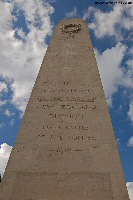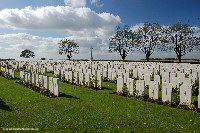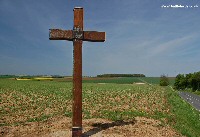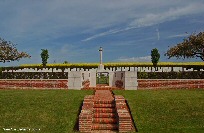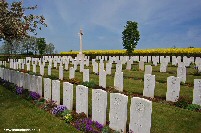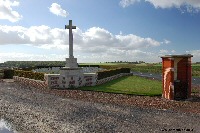Longueval and area
The World War One Battlefields site is undergoing a major update, with pages being converted to a new, user-friendly mobile format. The updated pages can be found at Updated World War One Battlefields. Some pages such as this one remain in the original format pending update.
There are now three pages on the site dealing with areas close together, with High Wood as the focus. In order to make the pages of a reasonable length, there are now separate pages to cover High Wood itself, the area near High Wood (including Bazentin-le-Petit, Martinpuich and Flat Iron Copse), and this page, covering the village of Longueval and cemeteries nearby.
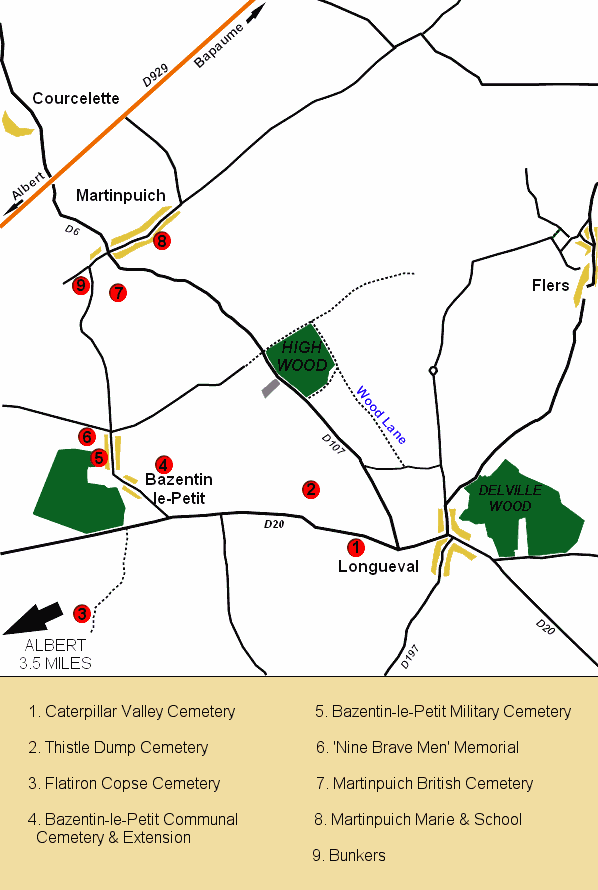
Map of High Wood and the area around
Longueval village
The village has a number of interesting sites, and also a cafe/bar in the centre where the roads meet. In the centre of the village, next to recycling bins near the church stands a British trench mortar. This would have been used for short-range bombardments of enemy positions, with this large calibre model being introduced late in 1916.
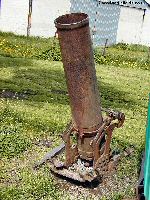
British trench mortar in Longueval
Also in the village is a fairly recent memorial which has evoked a certain level of controversy in terms of it's aesthetic value. This is the Pipers Memorial, unveiled in July 2002 to commemorate the pipers who fought in the Great War. Cap badges of regiments which lost pipers are inset into the brick wall behind the statue, and there is a 'Circuit de Souvenir' sign near to it.
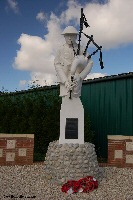
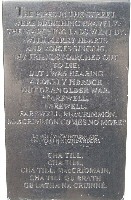
The Pipers Memorial at Longueval, with the inscription shown right
Not far to the north of the village, along a very small road which runs left off the D197 is a New Zealand Memorial, commemorating the actions of the New Zealand Division on the 15th of September 1916. This is located in the centre of the small road which loops either side of it. The memorial is similar to other New Zealand memorials which can be found at Messines and near s-Gravenstafel, being in the form of a large obelisk. On the front is the inscription "In honour of the men of the New Zealand Division, first batle of the Somme, 1916", and at the base "From the uttermost ends of the Earth".
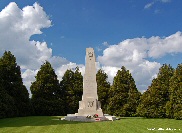
New Zealand Memorial near Longueval
The New Zealanders were first in action on the Somme on the 15th of September 1916, when they were involved in the action involving tanks when Flers was taken. They were also involved near the Butte de Warlencourt in November 1916. One of their Memorials to their Missing can be seen at the nearby Caterpillar Valley Cemetery.
Caterpillar Valley Cemetery & Memorial
Caterpillar Valley Cemetery is located on the south side of the D20 road which runs between Longueval and Contalmaison. It should be noted that it is not actually in Caterpillar valley, which is located around a mile or so to the south-west. This was originally a small cemetery, which was started in August 1918, and these original graves form Plot One of the cemetery today. They are of men of the 38th Division and the 6th Dragoon Guards who died in 1918. There are three rows of eight headstones in Plot One, although the CWGC website states that there are 25 rather than 24 original graves.
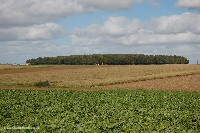
High Wood on the horizon, seen from near Caterpillar Cemetery
After the Armistice, a further 31 plots were created here, and these graves are mainly of men who fell during the autumn fighting in 1916. It is thus a large cemetery, with 5,568 men buried or commemorated here. Of these, 3,795 (or 68%) are unidentified. This is a very high figure, and reflects the state of the bodies of men who died in 1916 when they were recovered three or more years later, and the difficulty in then identifying them.
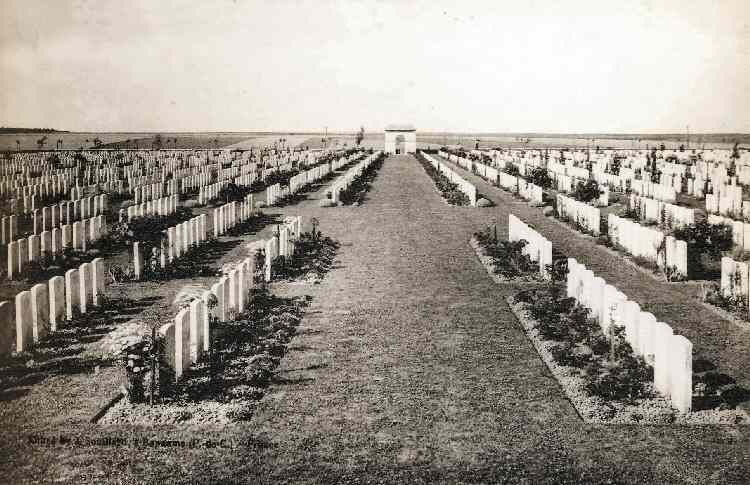
A view of Caterpillar Cemetery between the Wars. Photo: J. Souillard
The CWGC do a superb job in maintaining the many cemeteries on the Western Front, in other theatres and in the UK itself, and as you visit cemeteries you often see them working. On one visit to Caterpillar Valley Cemetery they were working on the headstones with compressed air to clean and renew the inscriptions (see photograph below).
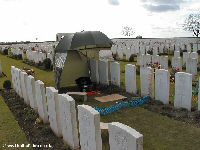
Renewing grave inscriptions at Caterpillar Cemetery
The rear wall of the cemetery is more or less where the German trench line ran which was captured by men of the 12th Royal Scots and 9th Cameronians on July the 14th, 1916. Also at the rear of the cemetery are special memorials - three to men who were killed in action in 1916, and buried in McCormick's Post Cemetery near Flers, but whose graves were later destroyed. At the back right are 32 special memorials to men known or believed to be buried at Caterpillar Valley Cemetery. Interestingly, there appear to be two 'gaps' in the row of special memorial stones, towards the right hand end.
One of the men commemorated by a special memorial at Caterpillar Valley Cemetery is Richard Haskayne Johnson. Although the lettering is weathered and fading, it records that his remains are "believed to be buried here", in one of the graves marked as 'A Soldier of the Great War, Known Unto God'.
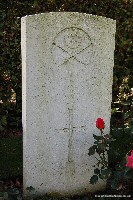
Special Memorial to Richard Haskayne Johnson
I was contacted through this website by Kevin Broadfoot, who is Richard Johnson's great grandson. Kevin provided the picture of Richard Haskayne Johnson shown below, and also the information I have been able to add here. Johnson's death simply devastated his wife and children and when Kevin was a child, the story of his death was frequently related to Kevin and his cousins by his grandmother. There was a permanent sense of loss and injustice amongst his children. Lacking any other means of support, Richard Haskayne Johnson's wife had to re-marry but never really got over her sense of loss and died at a relatively young age a few years later. This story made a deep impression on Kevin as a child.
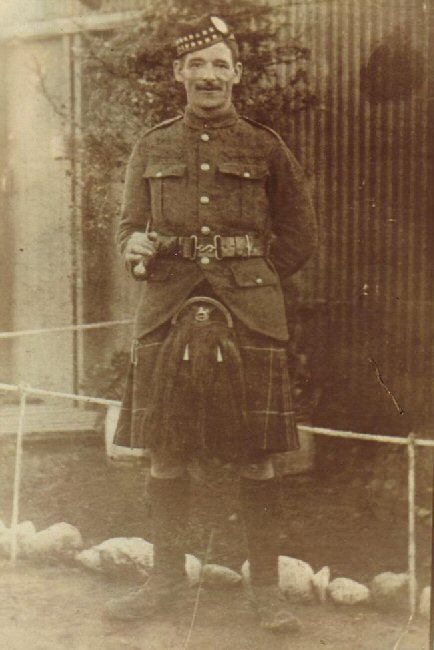
Richard Haskayne Johnson. Photo by kind permission of Kevin Broadfoot
Richard Johnson came from the Everton area of Liverpool and was married with 3 children. It would seem that he enlisted around the end of 1917, probably joining up at the local enlisting office with the Liverpool Scottish. At some stage he was transferred into the Machine Gun Corps, and when he died he was with the 38th Battalion of the MGC, which served with the 38th Welsh Division. He was killed on the 27th of August 1918. He was about 38 or 39 when he joined up and had been working on the River Mersey in Liverpool as a seaman on the tug boats. He was thus in a 'reserved' occupation and didn't have to enlist. However, he did so after an argument with his boss, when he worked his shift and then that of a friend who had influenza.He expected to receive his friend's wages and then take it to the family. But on pay day his boss refused to pay him both wages and during an argument told him there was a khaki suit waiting for him! Richard Haskayne Johnson joined up in a fit of pique on the way home - and was dead less than nine months later. Today, the exact location of his grave is unknown, although it is believed to be one of many in the cemetery inscribed as "A Soldier of the Great War, Known Unto God".
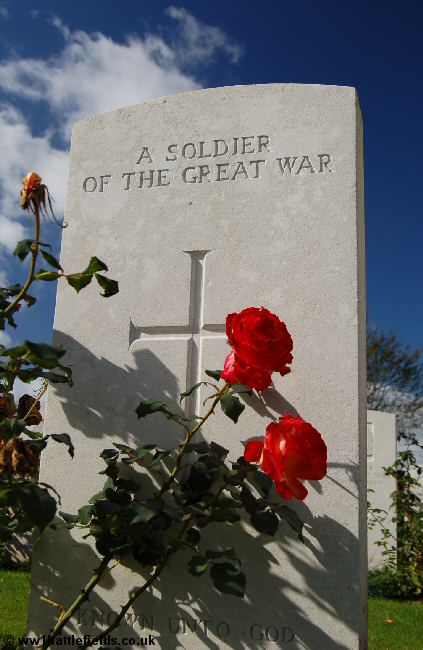
One of the many 'Known Unto God' graves in Caterpillar Valley Cemetery
Also located at this cemetery is one of New Zealand's Memorials to the Missing. New Zealand decided not to have the names of its soldiers whose bodies had never been recovered or identified commemorated on the Thiepval Memorial on the Somme or the other Memorials to the Missing such as the Menin Gate. Instead, there are seven New Zealand memorials to the missing in France and Belgium, and these have been placed in cemeteries which were appropriate to the fighting in which those listed on each died. The memorial at Caterpillar Valley Cemetery comprises ten panels with the names of soldiers arranged by regiment, and a central panel with the inscription "Here are recorded the names of officers and men of New Zealand who fell in the battles of the Somme September and October 1916 whose graves are known only to God".
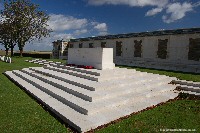
The New Zealand Memorial to the missing at Caterpillar Valley Cemetery
New Zealand's Unknown Warrior was exhumed from one of the Unknown graves (Plot 14, Row A, Grave 27) here at Caterpillar Valley Cemetery and handed over to New Zealand representatives on the 6th of November, 2004. On the 10th of November, the casket arrived in New Zealand, where there was a ceremony at Wellington Airport. It was then taken to the New Zealand Parliament building, where the body lay in state, and was visitied over the night of the 10th to 11th of November by an estimated 10,000 New Zealanders who wished to pay their respects. On the 11th of November, 2004, more than 100,000 saw the funeral procession on its way to the National War Memorial, where the Unknown Warrior was buried with full military honours. More information can be found on the National War Memorial Government website.
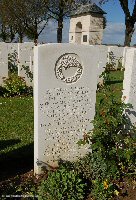
Stone marking where the New Zealand Unknown Warrior was buried at Caterpillar Cemetery
During the war, the 1st Battalion East Yorkshires erected a wooden battlefield memorial with rails at a spot about a mile and a half north of Caterpillar Valley Cemetery, near Eaucourt L'Abbaye (between Le Sars and Flers). The memorial was located on the site of Goose support trench.
By May 1920, the memorial had been moved to Caterpillar Valley Cemetery, although no trace of it remains today. There were many other temporary wooden battlefield memorials erected during or just after the war, very few of which still survive, but near to Caterpillar Valley Cemetery is a replacement of another - the Bristol Cross. This memorial to the 12th Battalion, the Gloucester Regiment, is located just outside Longueval, south-east of High Wood. The battalion was involved in an attack near here on the 29th of July. Once again, this location (see picture below) illustrates the elevation advantage of High Wood. The cross that stands here today is not the original; that was erected in the 1920s, but had vanished by the end of the Second World War. In 1986 this replacement (made in Bristol) was put in place. Records at the National Archives suggest that the Gloucesters erected a wooden memorial very near this spot during the War, although the 11th battalion is listed rather than the 12th (this may have been written in error).
Thistle Dump Cemetery
This small cemetery is closer to High Wood, lying away from the D20 road on the opposite side from Caterpillar Valley Cemetery, and a little further towards Bazentin-le-Petit village. The cemetery is reached by a signposted track. A dressing station was based here, an area safe from view from High Wood due to the contours of the land. A trench called Thistle Alley ran up the hill just to the right of the cemetery. The iron harvest in this area is particularly plentiful, as the areas around High Wood were the subject of long and intense bombardments as the battles of 1916 raged.
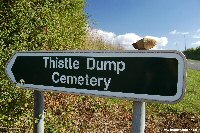
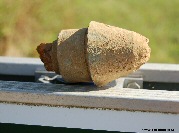
Itron harvest on the sign to Thistle Dump Cemetery
The first burials at this cemetery were in August 1916, before High Wood was taken, and this position must have been uncomfotable with High Wood out of sight but just over the horizon. The cemetery was used until February 1917, and seven Germans were also buried here. After the Armistice, more than 50 graves were concentrated here, the total number today being just short of two hundred, with 59 unidentified. The cemetery is isolated and surrounded by fields, in he right season of yellow rape, bordering the cenetery with bright vibrant colour. There are two special memorials to men known to be buried here on either side of the entrance. The rows of graves are regular, but the graves are not evenly spaced. There are a number of German soldiers buried in the rows along side British men, and there are also Australians and New Zelanders, including at least one Maori, buried here.
Not far from Thistle Dump Cemetery I recently saw a Mills bomb lying in the soil by the edge of the field. I took a photograph, but left it where it was.
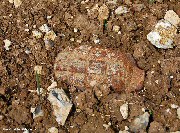
Grenade near Thistle Dump Cemetery
Longueval Road Cemetery
This cemetery, and also Bernafay Wood Cemetery (see below) are reached by returning to the village and following the D197 south towards Maricourt. On the left hand side, Longueval Road Cemetery is the first reached. This is a small cemetery, which was started in September 1915. It was located near a dressing station which was known as 'Longueval Alley', or 'Longueval Water Point'. A trench, or possibly the road itself here, was known as Pall Mall in September 1916. The cemetery was used until January 1917 and briefly again in August and September 1918.
Many of the graves are from October and November 1916. The graves are in regular rows, although within rows the spacing between graves is quite varied. The Cross of Sacrifice is at the triangular apex of the cemetery, and there are special memorials to two men known and one believed to be buried here. From the Cross of Sacrurifice, one can look straight ahead over the cemetery to see Bernafay Wood ahead. Trones wood can be seen to the left, with Delville wood behind you. The road and track layout here is just the same today as it was during the Great War.
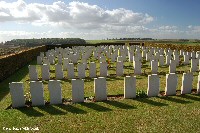
Longueval Road Cemetery with Bernafay Wood visible behind
There were 171 graves here by the Armistice, and another 50 or so were brought into the cemetery in 1923-1924. Most are of identified soldiers, although nearly 50 are 'Known Unto God'.
Serjeant Walter Poulter of 'B' Battery, 190th Brigade Royal Field Artillery died of wounds on the 26th of September 1916, aged 29. He is buried in row C, and had travelled further than most to fight. His parents lived in Plumstead in London, but Walter had come from China (where he had served with the Maritime Customs) with the Shanghai Volunteer Contingent.
Bernafay Wood British Cemetery
Further on down the same road is Bernafay Wood, and Bernafay Wood British Cemetery British Cemetery. On the wall when I took these photographs in October 2006 someone had left some 'iron harvest' including the nose-cone of a shell, as shown below. A Dressing Station was located here in August 1916, and the cemetery was started beside it. It was a front-line cemetery, used until April 1917, and trenches ran very nearby this spot. By the Armistice there were 284 burials here, and after the Armistice graves from Bernafay Wood North Cemetery were concentrated here, and other bodies recovered from the battlefields immediately east of the wood were also buried here, bringing the total up to around 950. Of these, nearly half are unidentified.
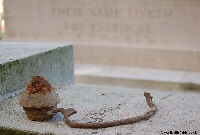
Iron Harvest at Bernafay Wood Cemetery
Bernafay Wood can be seen on the opposite side of the road from the cemetery. Special memorials and Duhallow blocks are located behind the Great Cross at the rear of the Cemetery to commeorate twelve soldiers buried in Bernafay Wood North Cemetery whose graves were destroyed by shell fire. The number '12' on the Duhallow block which provides the information has obviously been replaced since it was originally carved - presumably because the grave of at least one man has been subsequently rediscovered.
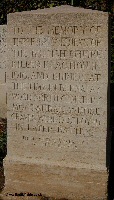
Inscription in memory of soldiers originally buried at Bernafay Wood North Cemetery: the number was not originally 12
Other special memorials to soldiers known or believed to be buried here are located at the front left of the cemetery. Many of the headstones are badly weatherd and hard to read, but the CWGC have a continous rolling programme to restore headstones so these will no doubt be dealt with in time.
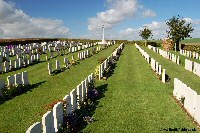
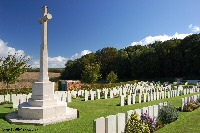
Bernafay Wood British Cemetery
Sources/Acknowledgements
Kevin Broadfoot for information on, and permission to use the photograph of Richard Haskayne Johnson
Commonwealth War Graves Commission website
Major & Mrs. Holt: Battlefield Guide to the Somme
Chris McCarthy: The Somme - the day by day account
Martin & Mary Middlebrook: Somme Battlefields
National Archives: Files on battle memorials
Dave O'Mara for information relating to the site of the 1/East Yorkshire memorial location
Paul Reed: Walking the Somme
Somme 1916 website

